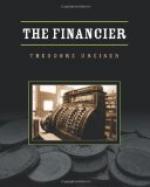So came Lillian Semple, who was nothing more to him than the shadow of an ideal. Yet she cleared up certain of his ideas in regard to women. She was not physically as vigorous or brutal as those other women whom he had encountered in the lupanars, thus far—raw, unashamed contraveners of accepted theories and notions—and for that very reason he liked her. And his thoughts continued to dwell on her, notwithstanding the hectic days which now passed like flashes of light in his new business venture. For this stock exchange world in which he now found himself, primitive as it would seem to-day, was most fascinating to Cowperwood. The room that he went to in Third Street, at Dock, where the brokers or their agents and clerks gathered one hundred and fifty strong, was nothing to speak of artistically—a square chamber sixty by sixty, reaching from the second floor to the roof of a four-story building; but it was striking to him. The windows were high and narrow; a large-faced clock faced the west entrance of the room where you came in from the stairs; a collection of telegraph instruments, with their accompanying desks and chairs, occupied the northeast corner. On the floor, in the early days of the exchange, were rows of chairs where the brokers sat while various lots of stocks were offered to them. Later in the history of the exchange the chairs were removed and at different points posts or floor-signs indicating where certain stocks were traded in were introduced. Around these the men who were interested gathered to do their trading. From a hall on the third floor a door gave entrance to a visitor’s gallery, small and poorly furnished; and on the west wall a large blackboard carried current quotations in stocks as telegraphed from New York and Boston. A wicket-like fence in the center of the room surrounded the desk and chair of the official recorder; and a very small gallery opening from the third floor on the west gave place for the secretary of the board, when he had any special announcement to make. There was a room off the southwest corner, where reports and annual compendiums of chairs were removed and at different signs indicating where certain stocks of various kinds were kept and were available for the use of members.




